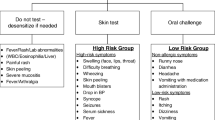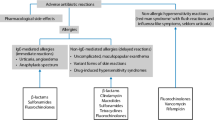Abstract
Antibiotic allergies are frequently reported in both adult and pediatric populations. While a detailed drug history is essential in the evaluation of antibiotic allergy, the history is typically insufficient to determine the presence of a drug allergy. The most readily available diagnostic testing for evaluating antibiotic allergies are drug skin testing and drug challenges. This review will focus on updates in the evaluation of antibiotic allergy utilizing immediate skin tests, delayed intradermal testing, drug patch tests, and drug challenges for both adults and children with histories of antibiotic allergies.
Similar content being viewed by others
References
Papers of particular interest, published recently, have been highlighted as: • Of importance •• Of major importance
Macy E, Ho NJ. Multiple drug intolerance syndrome: prevalence, clinical characteristics, and management. Ann Allergy Asthma Immunol. 2012;108:88–93.
del Real GA, Rose ME, Ramirez-Atamoros MT, et al. Penicillin skin testing in patients with a history of beta-lactam allergy. Ann Allergy Asthma Immunol. 2007;98:355–9.
Nadarajah K, Green GR, Naglak M. Clinical outcomes of penicillin skin testing. Ann Allergy Asthma Immunol. 2005;95:541–5.
Park MA, Markus PJ, Matesic D, et al. Safety and effectiveness of a preoperative allergy clinic in decreasing vancomycin use in patients with a history of penicillin allergy. Ann Allergy Asthma Immunol. 2006;97:681–7.
Rawlins MD, Thompson W. Mechanisms of adverse drug reactions. In: Davies DM, editor. Textbook of adverse drug reactions. New York: Oxford University Press; 1991. p. 18–45.
Coombs RRA, Gell PGH. Classification of allergic reactions responsible for clinical hypersensitivity and disease. In: Gell PGH, Coombs RRA, Lachman PJ, editors. Clinical aspects of immunology. Oxford: Blackwell Scientific; 1975. p. 761–81.
Pichler WJ. Delayed drug hypersensitivity reactions. Ann Intern Med. 2003;139:683–93.
Solensky R, Khan D, Bernstein I, et al. Drug allergy: an updated practice parameter. Ann Allergy Asthma Immunol. 2010;105(4):259–73.
Macy E, Schatz M, Lin CK, et al. The falling rate of positive penicillin skin tests from 1995 to 2007. Perm J. 2009;13:12–8.
Jost BC, Wedner HJ, Bloomberg GR. Elective penicillin skin testing in a pediatric outpatient setting. Ann Allergy Asthma Immunol. 2006;97:807–12.
Gadde J, Spence M, Wheeler B, et al. Clinical experience with penicillin skin testing in a large inner-city STD clinic. JAMA. 1993;270:2456–63.
Sogn DD, Evans R, Shepherd GM, et al. Results of the National Institute of Allergy and Infectious Diseases collaborative clinical trial to test the predictive value of skin testing with major and minor penicillin derivatives in hospitalized adults. Arch Intern Med. 1992;152:1025–32.
Macy E, Ngor EW. Safely diagnosing clinically significant penicillin allergy using only penicilloyl-polylysine, penicillin, and oral amoxicillin. J Allergy Clin Immunol In Pract. 2013;1:258–63. This study evaluates penicillin allergy in a real-world setting using only penicillin polylysine and penicillin G for skin testing, followed by amoxicillin challenge.
Levine BB, Zolov DM. Prediction of penicillin allergy by immunological tests. J Allergy. 1969;43:231–44.
Macy E, Burchette R. Oral antibiotic adverse reactions after penicillin skin testing: multi-year follow-up. Allergy. 2002;57:1151–8.
Park M, Matesic D, Markus PJ, et al. Female sex as a risk factor for penicillin allergy. Ann Allergy Asthma Immunol. 2007;99:54–8.
Lin E, Saxon A, Riedl M. Penicillin allergy: value of including amoxicillin as a determinant in penicillin skin testing. Int Arch Allergy Immunol. 2010;152:313–8.
Macy E, Richter PK, Falkoff R, et al. Skin testing with penicilloate and penilloate prepared by an improved method: amoxicillin oral challenge in patients with negative skin test responses to penicillin reagents. J Allergy Clin Immunol. 1997;100:586–91.
Bousquet PJ, Co-Minh HB, Arnoux B, et al. Importance of mixture of minor determinants and benzylpenicilloyl poly-L-lysine skin testing in the diagnosis of beta-lactam allergy. J Allergy Clin Immunol. 2005;115:1314–6.
Matheu V, Perez E, Gonzalez R, et al. Assessment of a new brand of determinants for skin testing in a large group of patients with suspected beta-lactam allergy. J Investig Allergol Clin Immunol. 2007;17:257–60.
Romano A, Bousquet-Rouanet L, Viola M, et al. Benzylpenicillin skin testing is still important in diagnosing immediate hypersensitivity reactions to penicillins. Allergy. 2009;64:249–53.
Torres MJ, Romano A, Mayorga C, et al. Diagnostic evaluation of a large group of patients with immediate allergy to penicillins: the role of skin testing. Allergy. 2001;56:850–6.
Empedrad R, Darter AL, Earl HS, et al. Nonirritating intradermal skin test concentrations for commonly prescribed antibiotics. J Allergy Clin Immunol. 2003;112:629–30.
Mori F, Barni S, Pucci N, et al. Sensitivity and specificity of skin tests in the diagnosis of clarithromycin allergy. Ann Allergy Asthma Immunol. 2010;104:417–9. This study systematically evaluates clarithromycin allergy with skin testing and blinded challenges.
Seitz CS, Brocker EB, Trautmann A. Suspicion of macrolide allergy after treatment of infectious diseases including Helicobacter pylori: results of allergological testing. Allergol Immunopathol (Madr). 2011;39(4):193–9.
Benahmed S, Scaramuzza C, Messaad D, et al. The accuracy of the diagnosis of suspected macrolide antibiotic hypersensitivity: results of a single-blinded trial. Allergy. 2004;59:1130–3.
Lammintausta K, Kortekangas-Savolainen O. Oral challenge in patients with suspected cutaneous adverse drug reactions: findings in 784 patients during a 25-year-period. Acta Derm Venereol. 2005;85:491–6.
Brož P, Harr T, Hecking C, et al. Nonirritant intradermal skin test concentrations of ciprofloxacin, clarithromycin, and rifampicin. Allergy. 2012;67:647–52.
Seitz CS, Brocker EB, Trautmann A. Diagnostic testing in suspected fluoroquinolone hypersensitivity. Clin Exp Allergy. 2009;39:1738–45.
Barbaud A. Skin testing in delayed reactions to drugs. Immunol Allergy Clin N Am. 2009;29(3):517–35.
Romano A, Viola M, Mondino C, et al. Diagnosing nonimmediate reactions to penicillins by in vivo tests. Int Arch Allergy Immunol. 2002;129(2):169–74.
Romano A, Gaeta F, Valluzzi RL, et al. Diagnosing nonimmediate reactions to cephalosporins. J Allergy Clin Immunol. 2012;129(4):1166–9.
Padial A, Antunez C, Blanca-Lopez N, et al. Non-immediate reactions to beta-lactams: diagnostic value of skin testing and drug provocation test. Clin Exp Allergy. 2008;38(5):822–8.
Barbaud A, Goncalo M, Bruynzeel D, et al. Guidelines for performing skin tests with drugs in the investigation of cutaneous adverse drug reactions. Contact Dermatitis. 2001;45(6):321–8.
Brockow K, Garvey LH, Aberer W, et al. Skin test concentrations for systemically administered drugs—an ENDA/EAACI Drug Allergy Interest Group position paper. Allergy. 2013;68(6):702–12.
Barbaud A. Skin testing and patch testing in non-IgE-mediated drug allergy. Curr Allergy Asthma Rep. 2014;14(6):442.
Lammintausta K, Kortekangas-Savolainen O. The usefulness of skin tests to prove drug hypersensitivity. Br J Dermatol. 2005;152(5):968–74.
Winnicki M, Shear NH. A systematic approach to systemic contact dermatitis and symmetric drug-related intertriginous and flexural exanthema (SDRIFE): a closer look at these conditions and an approach to intertriginous eruptions. Am J Clin Dermatol. 2011;12(3):171–80.
Andrade P, Brinca A, Goncalo M. Patch testing in fixed drug eruptions—a 20-year review. Contact Dermatitis. 2011;65(4):195–201.
Brahimi N, Routier E, Raison-Peyron N, et al. A three-year-analysis of fixed drug eruptions in hospital settings in France. Eur J Dermatol. 2010;20(4):461–4.
Ozkaya-Bayazit E, Bayazit H, Ozarmagan G. Topical provocation in 27 cases of cotrimoxazole-induced fixed drug eruption. Contact Dermatitis. 1999;41(4):185–9.
Barbaud A, Collet E, Milpied B, et al. A multicentre study to determine the value and safety of drug patch tests for the three main classes of severe cutaneous adverse drug reactions. Br J Dermatol. 2013;168(3):555–62. This large study evaluated the safety and utility of drug patch tests in various SCAR and is the largest experience in DRESS.
Aberer W, Bircher A, Romano A, et al. Drug provocation testing in the diagnosis of drug hypersensitivity reactions: general considerations. Allergy. 2003;58(9):854–63.
Hjortlund J, Mortz CG, Skov PS, et al. One-week oral challenge with penicillin in diagnosis of penicillin allergy. Acta Derm Venereol. 2012;92(3):307–12.
Demoly P, Romano A, Botelho C, et al. Determining the negative predictive value of provocation tests with beta-lactams. Allergy. 2010;65(3):327–32.
Messaad D, Sahla H, Benahmed S, et al. Drug provocation tests in patients with a history suggesting an immediate drug hypersensitivity reaction. Ann Intern Med. 2004;140(12):1001–6.
Kao L, Rajan J, Roy L, et al. Adverse reactions during drug challenges: a single US institution’s experience. Ann Allergy Asthma Immunol. 2013;110(2):86–91 e1.
Ramam M, Bhat R, Jindal S, Kumar U, Sharma VK et al. Patient-reported multiple drug reactions: clinical profile and results of challenge testing. Indian J Dermatol Venereol Leprol 2010;76:382–6.
Caubet JC, Kaiser L, Lemaitre B, et al. The role of penicillin in benign skin rashes in childhood: a prospective study based on drug rechallenge. J Allergy Clin Immunol. 2011;127(1):218–22.
Ponvert C, Perrin Y, Bados-Albiero A, et al. Allergy to betalactam antibiotics in children: results of a 20-year study based on clinical history, skin and challenge tests. Pediatr Allergy Immunol. 2011;22(4):411–8. Largest reported study of evaluation of beta-lactam allergy in children including data on more severe reactions.
Zambonino MA, Corzo JL, Munoz C, et al. Diagnostic evaluation of hypersensitivity reactions to beta-lactam antibiotics in a large population of children. Pediatr Allergy Immunol. 2013.
Kamboj S, Yousef E, McGeady S, et al. The prevalence of antibiotic skin test reactivity in a pediatric population. Allergy Asthma Proc. 2011;32(2):99–105.
Compliance with Ethics Guidelines
Conflict of Interest
Roland Solensky declares that he does consulting for Optimer Pharmaceuticals and that he and his institution have received grant money from Allerquest and Merck. David A. Khan declares no conflict of interest.
Human and Animal Rights and Informed Consent
This article does not contain any studies with human or animal subjects performed by the authors.
Author information
Authors and Affiliations
Corresponding author
Additional information
This article is part of the Topical Collection on Anaphylaxis and Drug Allergy
Rights and permissions
About this article
Cite this article
Solensky, R., Khan, D.A. Evaluation of Antibiotic Allergy: the Role of Skin Tests and Drug Challenges. Curr Allergy Asthma Rep 14, 459 (2014). https://doi.org/10.1007/s11882-014-0459-z
Published:
DOI: https://doi.org/10.1007/s11882-014-0459-z




